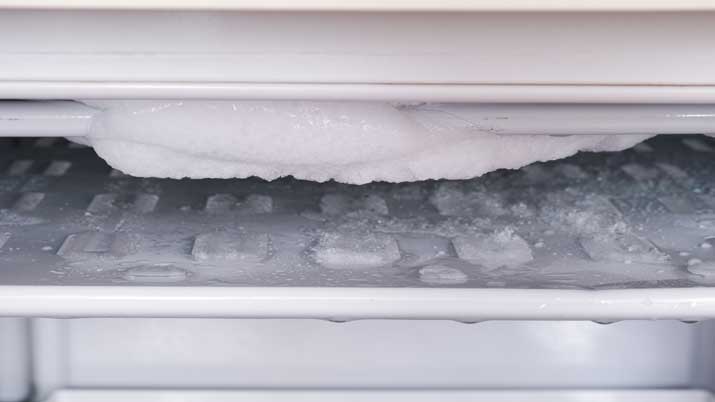How to clean a freezer
Learn how to clean a freezer properly with a little help from this guide

Learning how to clean a freezer doesn’t need to be a daunting task – with a little know-how, you’ll be deep cleaning your unit with ease. Larger models (such as chest freezers) will take more time than others, so make sure to set enough time aside to do a thorough job. Equally, an integrated under–counter model may require some bending down. In fact, how easy your model is for you to clean might be a consideration when you’re buying one of the best freezers.
We'll be covering exactly how to prep for the clean, how to clean a freezer using simple methods, as well as when and why you would need to defrost your freezer for best food hygiene. If you're in a rush and you want to know how to clean your freezer without turning it off, just remember that properly defrosting your freezer will provide the best results.
How to clean a freezer
So, do you have to defrost your freezer in order to clean it? For a full clean, yes. You can split out your cleaning into three main parts: cleaning the exterior of the unit, cleaning the interior drawers and compartments and cleaning the interior surface of the unit underneath any removable compartments.
You can achieve the first two without a complete defrost of your freezer. However, for a full deep clean that includes cleaning the interior of the freezer, you’ll need to defrost in order to remove any ice build-up and disinfect the inside surfaces beneath. This will increase the time the job takes, so plan accordingly.

Get the right cleaning materials
Get your cleaning materials together before you start your clean. For the cleaning process you will need:
• Disinfectant based cleaning fluid
• A dish cloth for cleaning
• A polishing cloth for buffing the exterior of your unit
• You may also find it helpful to wear rubber gloves in order to protect your hands from cleaning chemicals
Sign up to receive the latest news, reviews, buying guides and deals direct to your inbox
For defrosting the freezer:
• Spare towels you don’t mind getting wet
• Trays to catch ice water as it melts
• A hairdryer, if you want to speed up the melting process
Preparing for a deep clean
If this is your first time deep–cleaning a freezer, you’ll quickly realize that the preparation is a large part of the job. In order to get into the drawers to clean them, you will need to store any existing frozen food you have.
For this reason it can be a good idea to organize a deep clean just before you restock your freezer with frozen foods. Make sure that you store any frozen foods in cold enough conditions to ensure they stay safely frozen. For small amounts of frozen food your refrigerator may have a small internal ice box that you can use. For a larger solution you could use an ice chest packed with ice or ask a neighbor to temporarily store your food.
How to clean a freezer of ice build-up
Katie Sadler, Kitchen Brand Manager for Whirlpool gives us the following expert advice on how ice build up happens and when you know it’s time to defrost your freezer:
“Whenever you open your freezer, outside air enters the freezer and allows heat and moisture in. This moisture becomes frost inside your appliance, which can build up over time. Whirlpool brand recommends that you should defrost your freezer at least once a year or more frequently if your freezer is prone to ice build-up. If you noticed that the ice build-up is more than quarter of an inch thick, it’s time to defrost your freezer. If you are unsure about the specific instructions on how to defrost your freezer, please check your owner’s manual so you can do it successfully.”
To properly clean a freezer, you'll need to defrost it. To do this, unplug your appliance and let the ice melt. If you’re in a rush, a hair dryer on a low setting can help speed up the melting process.
Allow the ice to melt, using trays to catch the water as it melts away. Check in on the freezer approximately every 20 minutes to empty the trays and wipe away any excess water with the towels, ringing them out into a sink or bucket. When the freezer is completely free of ice, wipe down the surfaces with a damp cloth and disinfectant thoroughly.
Once you’ve tackled how to clean a freezer of ice build-up, make a mental note of when you cleaned it. Knowing how quickly your particular model builds up with ice can help you keep a check on it in the future.
Cleaning a freezer exterior and interior drawers
Wipe out any food residue or crumbs from the drawers. Then, wipe the surface again using disinfectant and a damp cloth to ensure that it's been fully sanitized. To ensure your compartments get a thorough clean all over, it may be easier to remove the drawers from your freezer entirely, clean them outside of the unit and replace them once dry.
Make sure that you clean the seal of your freezer properly. This is often a concertina shape that can attract debris and dust, so get your cleaning cloth into the crevices.
Wipe down the exterior of your unit to get rid of any spills and stains with a disinfectant and a damp cloth. Afterwards, use a polishing cloth to buff away any watermarks and get your freezer gleaming.
Defrost your freezer regularly to keep your unit fully clean
It’s well known that ice build-up in your freezer can increase your energy consumption, but there’s another good reason to keep it at bay: germs. Certain harmful bacteria and viruses such as salmonella and E-coli can survive at freezing temperatures. Learning how to clean a freezer properly also means learning to keep your ice build-up in check, to avoid any cross contamination.
Tanisha started her career in commercial retail buying for one of Amazon UK’s Top 10 revenue grossing online homeware retailers. Years spent obsessing over homeware products made it an easy career switch to writing about them. Her freelance career has seen her craft customer-focused web content for brands big and small, as well as writing articles in the health, lifestyle, home and retail sectors.

